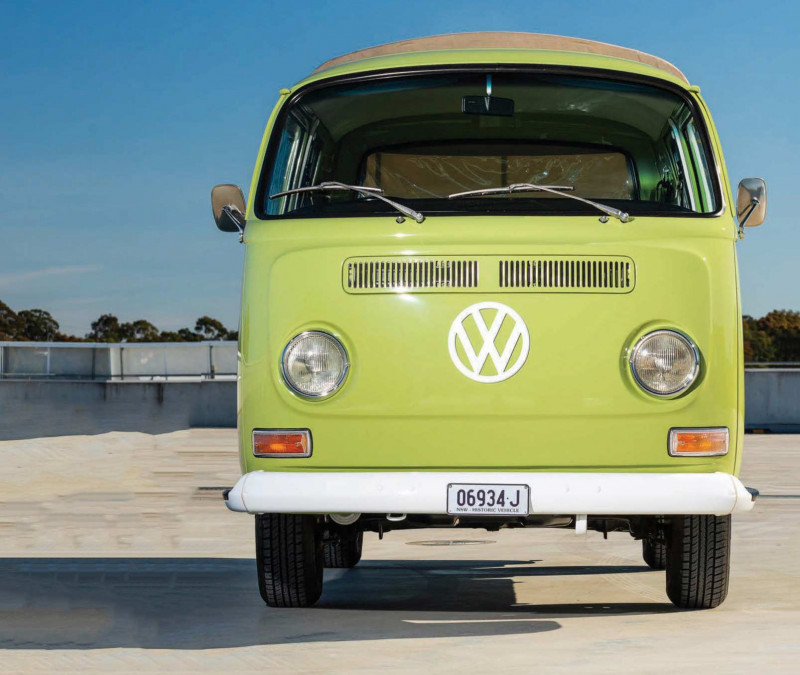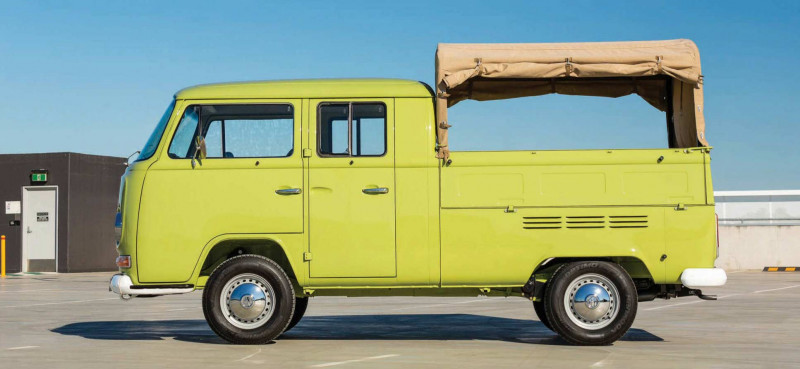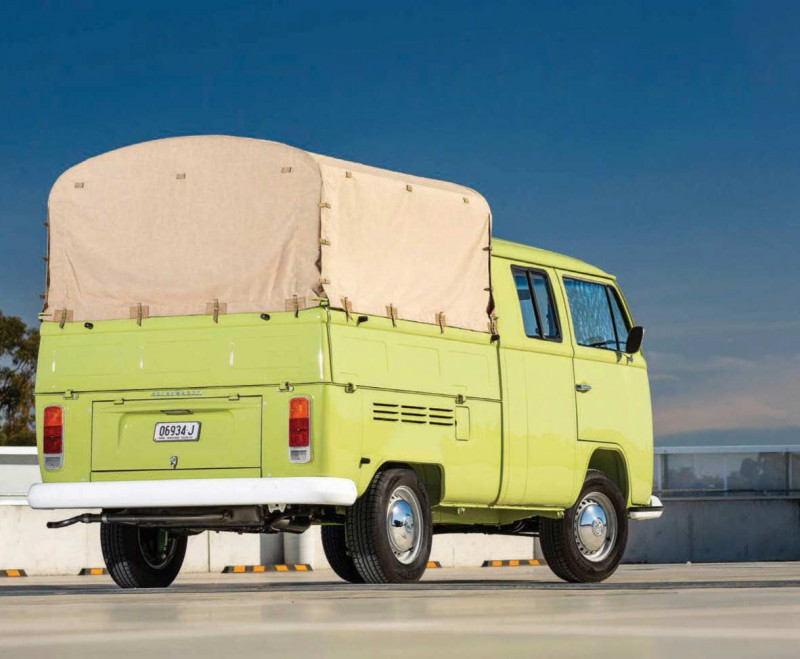Awesome 1972 Volkswagen Double Cab-commercial
When Wayne Murray bought this ’1972 Double Cab Pick-Up Bay as an unfinished project, he knew nothing of the headaches he’d face later on. Still, having spent the last eight years on a meticulous restoration, there’s no doubt it was worth all the grief. Words Ian Cushway. Photos Bob Hosking.
WAYNE’S WORLD Rare Double Cab Bay Window
IT’S THE BUSINESS! Awesome 1972 Volkswagen Double Cab-commercial
Over bought a vehicle without even seeing it? It’s easily done, especially if you fire up your computer after a few shandies. Well, that was far from the case with Wayne Murray, a 44-year-old cabinet maker from Sydney, Australia, when he snapped up this ’72 Bay truck – although the end result could have ended just as messily. “I knew what I was getting as I’d requested extra photos and had time to check out as many details as I could beforehand,” Wayne explained, “although not everything can be fully investigated.” By that he means probably the most important bit of a car, its identity, or in this case its true provenance.

“It wasn’t until I got home that I noticed that the chassis number wasn’t done in the original VW manner. It had a plate spot welded over where the original number should have been and the numbers were stamped onto this additional plate instead.”
To make matters worse, there was also a question mark over the identity of the engine. “The block had two sets of numbers stamped over the top of eachother, too. It was at that point I began to worry about the Bay’s origin, its integrity and, more to the point, the possibility that it had been stolen,” mused Wayne.
It’s (not) a steal
At this point, faced with an expensive, full-blown restoration on a vehicle you’ve just bought that might actually belong to someone else, most folk would have got cold feet, cut their losses and stripped it for spares. But not Wayne.
“I began to worry about the Bay’s origin, its integrity and, more to the point, the possibility that it had been stolen”
“I started by visiting the Road Maritime Services, the NSW road authority, with my chassis and engine numbers but they weren’t interested and suggested I try the local police. Which I did. However, they were even less sympathetic and said if it was stolen, they would have to come and seize it. I replied by saying, ‘if that was the case, I’d personally come and dump it on your desk!’ Obviously I was concerned about wasting a lot of time and money on something that could be taken away from me once it was finished!”

Anyway, to cut a long story short you’ll be relieved to know the policeman in question did tap in the details, and they all checked out. It wasn’t stolen and Wayne’s world suddenly became a lot happier. He’s since learned a couple of theories as to why there was a mix up with the numbers. “An owner with a ’72 DOKA, a South African import, had the same plate welded over the top. He suggested that during manufacture for some reason it was pulled from the production line and because the chassis numbers would have got out of sync, a plate was welded on top. Another possibility was that the panel had been replaced by one from another Kombi, but the reality is we’ll probably never know. And anyway, Wayne didn’t care – the worry was over, he’d finally been given the green light to crack on with getting the Bay registered and running again.
Why rush?
When we tell you Wayne’s spent the last 20 years looking for a rust-free, unmolested DC Ute, as he calls it, you’ll appreciate his sense of accomplishment getting this one. “I’ve got a ’76 Single Cab, but Double Cabs are rare and as prices kept rising and my requirements got refined to a ’72, the task of finding one became even harder. I eventually spotted this one – a rolling shell in Adelaide – on eBay, so I got the owner to bolt in the engine to make it easier to transport to my home in Sydney.”
“it was a bit like putting a 1000-piece jigsaw puzzle back together”
Now, we’ve possibly mislead you by saying that having sorted out the paperwork, Wayne was about to dive straight in to the restoration. Oh, no. First he had to play a waiting game for the thing to arrive, and even when it did eventually turn up, it was ages before work could get underway.

“I couldn’t find anyone willing to transport a non-running ’shell with no steering and no brakes but eventually found a bloke who worked for himself and agreed to do it. In his own time, of course! Then, I had to build a garage for it, so when it finally appeared it was put straight into storage for 2-3 years while I did it.” And then there was all the sifting through parts, one of the joys of buying an unfinished project. “There were a dozen or so boxes, so I had to go through them all, find out which bits I’d use and sell on the rest.” Oh year!
Wayne’s considered approach to the project also extended to the work that needed to be done to get it looking shipshape again. “The original plan was to finish off what had not been done to get it running again, so I made a long list of all the outstanding jobs, which included the bumpers, gates, interior, dash, all the electrics and the engine.” However, when Wayne’s painter discovered the battery tray wasn’t attached, and there was a mystery second hole in the gate buffer, it was time for a rethink. “I decided at that point to take a step back, start from scratch and do things properly because I knew I wouldn’t be happy touching up small areas and making short term fixes.” Consequently, Wayne had the ’shell bead blasted, which in turn lead to a far more extensive nut and bolt restoration.
“The blasting revealed that all the rust was cut out and the panels hadn’t been straightened correctly. Also, the bed was badly dented and holed and would need to be replaced. With a replacement bed and gates sourced from Das Resto, the Double Cab would spend another two and a half years in the bodyshop to make all the wrongs right and getting it into the shape you see it here.
That obviously gave Wayne time to find all the unique ’1972-only bits he needed for the restoration. “I wanted it to be as original as possible, and having been told I wouldn’t be able to find half the parts required to finish the Bus, I became more determined to find them. Some parts took 2-3 years to locate, but I found nearly all the bits I needed, and of course the internet helps. Some parts, though, I had to have remade, which meant finding someone to make them which was an additional challenge. Some were made in Australia, and I even had parts made in Turkey, which had its own set of challenges and risks.”
Body builder
Having got the body sorted, and resprayed in a shiny coat of Avocado Green (L60F), it took Wayne the best part of 18 months to reassemble, with all of the running gear being replaced with new OE parts or refurbished originals. The wheels are ’1971-’1972 correct (14x5.5) and have been blasted and powder coated pearl silver, and the hubcaps, headlight rims and door handles have all been rechromed. The front beam, still in its original paint with white reference numbers, had sat in his father’s shed for 40 years so looks like NOS. Another fuel tank was sourced as the one that came with the Bus wasn’t correct for the year and there was some head scratching when it came to working out the fuel tank breather system as there was little reference as to how it all sat in position. There is also one rubber which is Ute specific, which was sourced from Holland.
As for the engine, Wayne called on the experience of his father to enable him to rebuild it himself, using a crankshaft that was originally in his father’s ’72 Kombi, and a crank from his ’72 Microbus before he restored it. Oh, and he upped capacity to 1641cc while he was at it.
Wayne had to source an oil bath air cleaner as it’s ’72 Pick-Up specific. Said Wayne: “The aluminium tubing that goes from the left hand side air vents to the right side of the air cleaner came from Turkey. I had to order 10m and the cost of postage ended up being twice as much as the hose itself.”
Wayne even went to the trouble of welding back some of the broken tabs on the engine’s tinware before having the whole lot blasted and powder coated.
Vision on
Now, we mentioned at the start that Wayne is a cabinet maker by trade – and his trade connections came in particularly handy when it came to replacing the scratched rear window and quarter side windows. “I needed 5mm toughened glass and wanted the original ‘toughened’ logo on it, so I did a screenprint and asked a company I use who do glass splashbacks for kitchens to make the glass,” explained Wayne. “However, during the toughening process the rear screen shattered. My contact, who happens to be a car fan, revealed that his machine wasn’t really up to the job, but he knew someone who could help. To cut a long story short, all the glass was made – including the ink logo Wayne wanted – by another local factory. For nothing. “He said he owned my contact a favour, anyway, which was lovely as he had to stop production just to run through my few pieces of glass and I am very grateful for that,” smiled Wayne.
Take a bow
Because the canopy bows and bed slats were trash, Wayne borrowed an example of the latter from a fellow Kombi Club Australia member and had a wood shop in Sydney copy the profile. The wood is Cambia ash (American ash) which has been roasted, which stabilises the wood and gives it that lovely chocolate brown colour. The same shop did the canopy bows. Incidentally, the slats are held down by magnets instead of the usual pop rivets to avoid having to drill the new bed. Said Wayne: “Five magnets are used per slat with a pull strength of 4.6kg for each magnet and they were inserted with a router then glued into the wooden slat.”
The canopy itself is from Busware in the US, and the material is Sunbrella Tresco linen with tan nylon straps and trim. Meanwhile, the hoops were fabricated by a chap in Poland who makes them to the original specs. Said Wayne: “He sent them over in pieces for ease of transport and they were welded together by the painter and painted satin black once they arrived.” And finally…
That just left the inside to do, and Wayne approached the interior with the same incredible attention to detail as the rest of the build.
“The bench came with the Bus, I already had a driver’s seat and I managed to source the right year double passenger seat – so I had the frames media blasted and powder coated in a charcoal colour. The seats are covered in tan TMI basket weave material with Wolfsburg West coconut fibre padding. In truth, though, I’d rather have had them done properly by a trimmer.
“I couldn’t source the headlining I wanted as no material had both perforated hole and printed holes in the same material so I found someone on TheSamba in Germany who could make them.
“At the same time I had all the dash components repainted in the correct period colour (either black or L43 Grey black), and the steering wheel refurbished by Yesteryear Steering Wheels in Victoria. I’ve even managed to add a rare MPH trip meter and a period correct Motorola radio which I got from the States. Oh, and the speaker is a NOS item from Italy and a friend supplied an original under dash mount bracket so I could fit it.”
And that’s about it. Wayne’s chuffed to own something so unique – and desirable – his only ambition now being to get a complete collection of ’72 Kombis in the different configurations. And if there is indeed a next time, would he do anything differently, we enquired?
“I wouldn’t take on another unfinished project, especially if it’s a one-year-only model,” he laughs. “It’ll be less expensive to buy, but it’s hard finding parts and tricky knowing where everything goes – without any photo references and with nothing being labelled, it was a bit like putting a 1000-piece jigsaw puzzle back together without the box and picture.”
Thanks to: Troy Thompson at TNT Auto Body Repairs (tntautorepairs.com.au) and Gary’s Motor Trimming: Tel: (02) 9863 8054. Knowing what I want is the easy part; being able to deliver it isn’t as easy, so thanks to both companies for getting it spot on.
Wayne rebuilt the engine himself under the guidance of his father to 1641cc. That pipework was fabricated in Turkey and ended up costing an arm and a leg to post to Australia! Sunbrella Tresco linen tilt from US firm Busware looks fab and is a great fit.
Dash has been completely refurbished and now features a rare MPH trip speedo Front beam was a gift from Wayne’s dad having been in storage for years. It still boasts its white painted reference numbers. Seats have basketweave TMI covers and the rubber matts are reproductions.
“I had to build a garage for it, so when it finally appeared it was put straight into storage for 2-3 years”
Period-correct round centre rims were blasted and powdercoated pearl silver. Hubcaps were rechromed.


